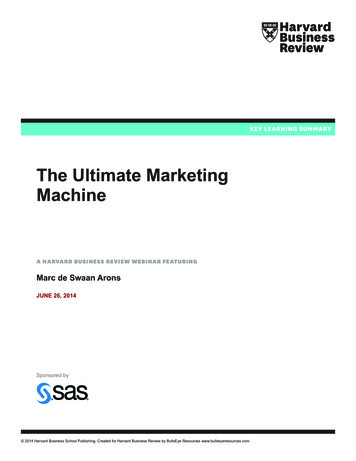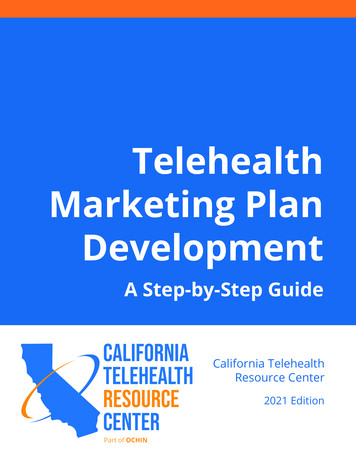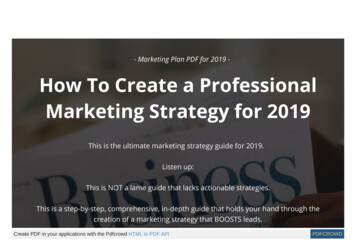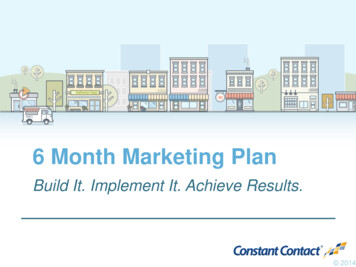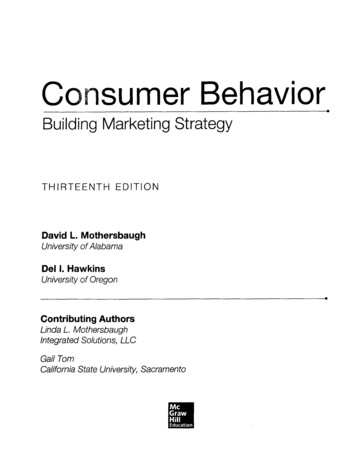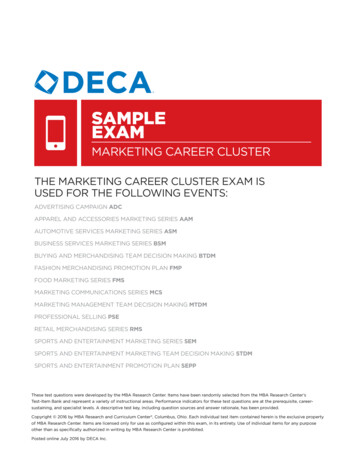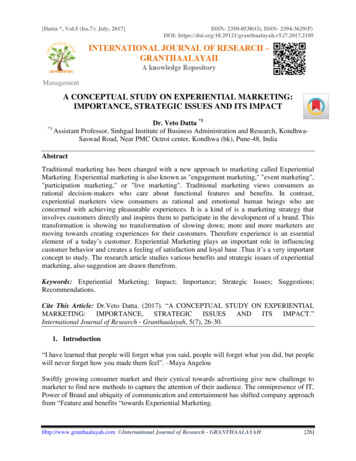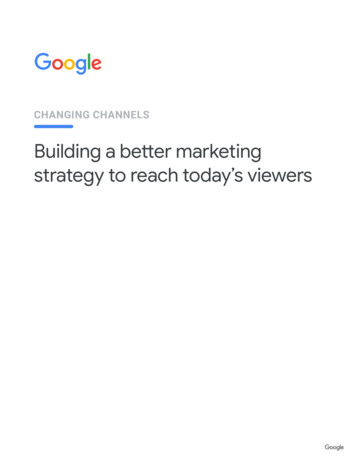
Transcription
CHANGING CHANNELSBuilding a better marketingstrategy to reach today’s viewers
Table of ContentsChanging ChannelsIntroduction – What we watch: New trends in video viewing03Chapter 1 – Reach a higher-quality audience:Move beyond basic demographic and household targeting04Chapter 2 – Motivate your customers to action:Build relevant experiences across environments12Chapter 3 – Take an end-to-end view of your campaigns:Align your TV and digital teams18Chapter 4 – Maximize your marketing investments:Use one tool across your video buys23Conclusion27Glossary28* Glossary term2
A short history ofthe living room TVSummaryThe way we watch TV has fundamentally changed. The popularity of ondemand and over-the-top video streaming, the proliferation of devices,and the availability of more high-quality content means that we’re ableto watch wherever, whenever and however we want. For viewers, thechoice of what to watch is wonderful. For marketers, it can make itmore challenging to reach their audiences. That said, it also providesan opportunity for marketers to better engage with consumers via datadriven media and creative strategies.This guide is all about that opportunity, how traditional and digitaltelevision are converging, and how marketers can adapt. We’ll explorehow the application of data and automated technology, coupled withaccess to more engaged audiences across screens and channels, canhelp marketers deliver better experiences to every individual.3
IntroWhat we watchNew trends in video viewingLet’s go back in time to September 14, 1952, just for a moment.On that evening, while Lucille Ball was battling a very fast conveyor belt at a chocolate factory on TV, a differentbattle was happening in the American living room around the television set — families debated which of the threebroadcast networks to watch: ABC, CBS, or NBC.On that particular evening at least, I Love Lucy won handily. The show had an astonishing 67.3 Nielsen rating in1952, a record that still stands.1 No matter what was broadcast each evening back then, it would be the talk ofthe town. At water coolers and drinking fountains throughout America, people came together to talk about thecountry’s hit show — since everyone had seen it.Having only three networks and a concentrated viewing audience meant that advertisers had it pretty easy. Thevariables were limited: one screen, three channels, and a few evening time slots to fill before the country hit thecollective sack. Advertisers knew when, where, how, and what the whole country was watching without the needfor sophisticated technology, data collection, or analysis.1Wikipedia, List of most watched television broadcasts4
What we watch: New trends in video viewingToday’s television consumers and the power of choice91%Today’s television viewing landscape is very different. While TV screensstill account for 91% of our viewing time2, we’re now able to watch greatvideo content wherever, whenever and however we want.We are no longer beholden to the schedule dictated by the TV guide; wecan watch our favorite shows on-demand, whenever the mood strikes.For example, according to Nielsen, traditional TV watching has declined44% for 18–24 year-old viewers and 32% for 25–34 year-olds over thepast 5 years.3 Meanwhile, streaming video is on the rise. In 2017, 59%of American households had a streaming video subscription, comparedto just 38% in 2014.4 And video consumption on over-the-top (OTT)streaming* devices rose 35% year-over-year among adults 18–49.5TV screensaccount for 91%of our viewing timeFurther, we’re no longer limited to the big screen. While we may begin ashow on the couch, we can now pick up where we left off on our mobilephones, tablets, or laptops. Younger consumers are leading this trend.According to Nielsen, the average 18-24 year-old spent more than 90minutes watching video on smartphones in Q2 2017, which is 82% higherthan the average adult.6Conversely, videos that we only used to watch on our computers arenow getting streamed on the big screen. (Did you know that people nowwatch over 100 million hours of YouTube per day globally in the livingroom? 7 That rate grew 70% between Q3 2016 and Q3 2017.8)Possibly the best trend of all is the number of high quality shows that arecoming out every year. The total number of scripted shows on televisionand streaming platforms hit 487 in 2017, which surpassed the previousrecord of 455 the year before.9 And it’s not just traditional TV either —Netflix, Hulu, and Amazon swept the 2017 Emmys with shows like TheCrown, Stranger Things, and The Handmaid’s Tale. In total, streamingservices received 162 Emmy nominations in 2017, up from 91 in 2016and 51 in 2015.10The amount of high-quality video produced for digital is growing as well.For example, every month more than 1.5 billion people come to YouTubeto watch content, on channels ranging from The Ellen Show, which hasover 22 million subscribers, to the NBA, with over 8 million subscribers.1159%In 2017, 59% ofAmerican householdshad a streaming videosubscription, comparedto just 38% in 2014We are truly in a golden age of video! With more viewing options to pickfrom, people are becoming more intentional about what to watch. Whenthey find something they love, they engage deeply. More choice leads tomore attention leads to more engaged audiences that can be reachedacross more access points.2345Nielsen, The Nielsen Total Audience Report, Q2 2017Calculations based on Nielsen Total Audience Report Q2 2017 and Nielsen CrossPlatform Report Q2 2012Calculations based on Nielsen Total Audience Report Q2 2017 vs. Q2 2014Pivotal Research, TV Trends Dec. 2017 (data based on consumption for month ofDec. 2017 vs. Dec. 2016)6 Nielsen, The Nielsen Total Audience Report, Q2 20177 Google Internal Data, Global, Based on 7 day average for Living Room watchtime, June 20178 YouTube Internal Data, Global, Q3 2016 – Q3 20179 Wall Street Journal, Era of Peak TV Continues with 487 Scripted Shows in 2017, January 201810 LA Times, Streaming services led by Netflix pile up 2017 Emmy nominations, July 201711 YouTube Internal Data, Global, Jan. 20185
What we watch: New trends in video viewingMore channels, more challengesWhile this cross-screen viewing experience is great for us as viewers,it creates complexity for marketers. Marketers now need to reach andengage with their audiences across all these devices and channels. Thismeans the traditional model of broad, demographic-based TV advertisingis no longer enough. Instead, marketers have to tailor their advertisingto reach individuals based on how they like to watch. They have to buildmore relevant ads, because consumers’ expectations for ad quality andrelevance have increased as well.Staying up to date on all of these consumer trends can be tough,especially when it can seem like a new fad emerges every day. In arecent survey conducted by Harvard Business Review Analytic Services,only 30% of respondents said that the marketing professionals in theirorganizations are “very knowledgeable” about the changing viewingtrends and the resulting advertising needs.But there is a business imperative to staying close to these consumertrends: the “very knowledgeable” businesses are three times as likely tosay they are adapting their strategies to a “great extent” in response tochanging viewing trends, compared to their less knowledgeable peers.1230%Only 30% ofrespondents saidthat the marketingprofessionals in theirorganizations are “veryknowledgeable”about the changingviewing trendsMarketers who understand how viewer behavior is changing are leadingthe way in rethinking their approach to reaching these audiences and willlikely gain an advantage through more successful campaigns.Ultimately, although there are new challenges, there is also a greatopportunity for marketers. The growth of viewing on internet-enableddevices has created a richer dataset that can help marketers understandtheir customers’ preferences and interests. And progress has been madein programmatic advertising technology — software that automaticallyand intelligently purchases ads — such that marketers now have toolsto take action on their customer understanding, at scale. As traditionaland over-the-top TV inventories become available in these programmaticplatforms, marketers will be able to build advanced TV advertising*strategies and apply data-driven and automated buying techniques totraditional TV audiences as well.The chapters in this guide provide four recommendations for howmarketers can seize this opportunity and use programmatic dataand technology to build a more effective advertising strategy toreach audiences wherever they are choosing to watch.12Harvard Business Review Analytic Services Google-commissioned research, “Marketingand the Evolution of TV,” Global, Feb. 2018 [390 respondents drawn from the HarvardBusiness Review audience of readers (magazine/ newsletter readers, customers,HBR.org users) completed the survey.]6
ReviewWhat we watchNew trends in video viewingWatch wheneverWatch wherever and howeverWatch whateverWith many more on-demandConsumers can now viewHigh-quality TV-like content is gettingviewing options, consumers canprofessionally-produced videocreated from all corners, buildingchoose when they want to watchcontent on any device -- from theira much broader library to choosetheir favorite shows.big living room screen down to thefrom. Greater choice leads to deepersmall screen in their pocket. Thisengagement once consumers findmeans they can watch whereversomething they love.they want!7
01Reach a higher-qualityaudienceMove beyond basic demographic and household targetingWhile brand marketing is still about reaching a broad audience,marketers can use the data made available through a programmaticplatform to develop strategies that reach individuals wheneverpossible, rather than households. To do this, you need to movebeyond basic demographic profiles, such as age and gender, anduse more granular audience data, such as context, interests andintent to purchase, to reach people who will actually be interested inyour offering.Campaigns that build individualized marketing strategies aremore effective than broad demographic based strategies. A 2017Google study found that campaigns that use intent-based targeting(targeting based on signals of intent to purchase) on mobile have20% higher Ad Recall lift and 50% higher Brand Awareness liftrelative to campaigns that only use demographic targeting.1313Google, Brand Lift Targeting Analysis, October 2016 – March 201750%Campaigns that useintent-based targetingon mobile have 20%higher Ad Recall liftand 50% higher BrandAwareness lift8
Reach a higher-quality audienceBrand awareness campaigns require “quality” reach strategiesAt the beginning of the customer journey, where your goal is to drivebrand awareness, you should maximize quality reach rather thanfocusing purely on audience numbers. Evaluate quality based onwhether the audience you are reaching can see your ad, whetherthey are engaged and interested in your message, and whether thesurrounding content is aligned with your brand values.To reach a broad and engaged audience, you can no longer blanketa market with a general message and assume that because your30-second commercial aired in millions of households, you actuallydrove awareness of your brand for that many people. Your targetaudience may be spending increasing amounts of time engaging withmedia other than TV, such as gaming or social apps. They may evenbe multitasking in these contexts while watching TV. Instead, you haveto reach people across devices and media channels (e.g. over-the-topvideo streams) in addition to traditional TV, where they are increasinglyspending their time.Evaluate qualitybased on viewability,engagement, andplacement suitabilityProgrammatic technology can help you find these engaged audiencesacross devices and channels from a single tool, so that the moneyyou’re spending on each channel is contributing effectively to youroverall campaign reach. For example, by planning all types of mediatogether, and measuring cross-channel campaigns with comparablemetrics, you can understand what audiences you’re reaching on TV andfind additional reach with similar audiences on digital channels.Quality reach also depends on ensuring that your brand shows upon high-quality content and placements. Make sure to choose atransparent platform that helps you measure and verify the quality ofthe inventory your ads run against. Ensure there are robust ad fraudprevention and reporting tools, as well as controls to determine whattypes of media placements are suitable for your brand. Use filters tooptimize for digital placements with higher viewability, audibility, andattention rates.By taking precautions to protect your brand, you can maximize thebenefits of digital reach while minimizing some of the risk associatedwith fraud and inventory suitability for your brand.9
Reach a higher-quality audienceBrand consideration campaigns require moreadvanced targeting strategiesWhen you want to move people through their purchase journey andhelp them understand why your brand or product will solve theirneeds, you need to apply more targeted strategies to your media buy.For digital audiences, you can use interest and intent data to betterreach people that will be interested in your message or offering. Forexample, you can understand what activities and products people areinterested in to reach the audience most likely to engage with yourbrand. You can also leverage intent-rich signals, such as what peopleare searching for, to provide better solutions to their in-the-momentneeds.For traditional TV audiences, targeting has historically been limited tobroad categories like age and gender. In more advanced cases, indexbased approaches have been used to target more granular audiences(using survey data to identify TV programs that align with audiencesrelevant to your brand). But this is changing. Traditional (linear) TVinventory is becoming available to buy through programmatic pipes,paving the way for more granular audience-based targeting thatmirrors what’s possible today in digital.Addressable TV advertising* allows marketers to deliver different adsto different households, within a given TV program. You can tailor themessages that show up to each household based on audience dataabout the cable subscriber and household viewing behavior. Whilethis doesn’t get you down to the individual targeting level, addressableadvertising does help you apply audience data to more selectivelytarget TV viewers and show them relevant messages.For digital audiences,you can use interestand intent data to betterreach people that willbe interested in yourmessage or offeringAs consumers spend more time watching TV content on otherdevices and as set-top boxes get upgraded and can handleaddressable ads, there will be more opportunities to segmentyour audience and target them appropriately. By employing thesestrategies, even for broad brand campaigns, you can reach a higherquality audience who is more likely to be interested in your offering.10
ReviewReach a higher-qualityaudienceCHAPTER 3Move beyond basic demographic and household targetingCHAPTER 3Marketers need to connect with video-viewing audiences on the level of individual interests, acrossdevices. Having a unifying tool — one that applies programmatic data and technology to both linear anddigital video experiences — gives them this ability.Inventory AccessBrand AwarenessBrand ConsiderationApply data-driven andRaise awareness among aUse cross-channel audienceautomated buying techniquesbroad set of qualified customersinsights (such as interestsacross channels to the fullacross TV and digital — whileand intent, in addition torange of video inventory — fromensuring quality of reach,demographics) to reachlinear TV to digital video —maintaining brand safety, andpeople who are aligned to yourwhere and when appropriate inminimizing duplication.brand at their most engagedaccordance with each individualmoments.customer’s journey.11
02Motivate your customersto actionBuild relevant experiences across environmentsThe best ads tell stories that pull people in, capture their attention and change their perception or prompt themto take action. Once you’ve found the right audience, it’s time to deliver a message that resonates.Research suggests that creative quality is the most important factor for driving a campaign’s effectiveness.14Ads that are relevant to the viewer or feature people similar to the viewer get triple the average attention.15 Ifyour message isn’t relevant, people won’t pay attention.Given today’s viewing landscape, the standard 30-second in-stream TV spot is no longer relevant in all thecontexts where people are choosing to watch. For example, engagement on mobile devices is typically shorter innature and often occurs within apps, so a 30-second ad may be too long and an in-stream placement may not beappropriate for that context. Further, a single message is probably not going to be relevant to all the people youwant to reach, nor will it be relevant for the same person once they have already seen it.You need to consider all the attributes of your ad — placement, length, and message sequence — to ensure yourmessage is relevant for the person viewing it and the context they’re viewing it in.1415Nielsen Catalina Solutions, Five Keys to Advertising Effectiveness, August 2017Google/Ipsos, Video Mobile Diary, US, 2017, n of 4,381 (saw ads occasions)12
Motivate your customers to actionChoose the best ad placementsSelecting the best ad placements in different environments is criticalto ensuring your viewers have a positive and engaging experiencewith your brand message. There are a variety of different placementsto consider.In-stream video placements are video ads that live alongside othervideo content. The traditional TV spot is the original example — a 15 or30 second video ad that runs between video programming. In-streamvideo placements are also available on digital video programmingacross desktops, tablets and smartphones. For example, there are instream video ads that run before, during or after some YouTube videos.As over-the-top video viewing has grown, in-stream video placementshave also become available within over-the-top services such as Hulu orCBS.com and across digital devices such as connected TVs. Internetenabled TV inventory brings together the benefits of traditional TVand digital video. While this new frontier is still evolving, it providesinnovative marketers with a highly engaged household-level audiencesimilar to traditional TV, coupled with the addressability of digital.52%52% of the gaming appaudience is female.Traditional in-stream videoplacements can’t capitalizeon these highly-engagedmoments. Out-stream canWhile consumer time continues to grow on these internet-connecteddevices, time is also being spent on high-quality non-video content.We’re spending increasing amounts of time reading blogs or thenews, playing games, and scrolling through social feeds. Researchfrom Google and Ipsos recently found that news, sports, gamingand entertainment apps together account for nearly an hour of timespent on mobile every day, and contrary to popular belief, they reacha diverse and engaged population. For example, 52% of the gamingapp audience is female.16 Traditional in-stream video placements can’tcapitalize on these highly-engaged moments.Out-stream video placements* — video ads positioned outside of videocontent — provide the ability to deliver engaging brand moments in abroader assortment of premium content environments, and in particularwithin mobile apps.16DoubleClick, Appify your campaigns: Reaching customers in apps, Nov 2017We’re spending increasingamounts of time readingblogs or the news, playinggames, and scrollingthrough social feeds13
Motivate your customers to actionThese out-stream placements include:In-feed and in-article video adsPlacements where video ads are positioned in afeed or within the text of an article. Usually theyare muted by default to ensure they don’t disruptthe user. Component-based native ads are acommon creative format that works well for infeed or in-article placements.Interstitial video adsPlacements where video ads are interspersedbefore, in between, or after the primary contentexperience and occupy the entire screen size.Rewarded ads are a common creative formatthat works well as an interstitial placement.These ads provide a reward in exchange forwatching them, such as extra lives in a game orextra listening time in a music streaming app.Nestlé achieved a 99.5% view-through rate on Android by partnering with mobile app game makerKing to serve ads to users in exchange for in-gamerewards.99.5%Top publishers such as Time Inc. and King Games are buildingout-stream video placements into their text-based pages. Nestlé, forexample, achieved a 99.5% view-through rate on Android by partneringwith mobile app game maker King to serve ads to users in exchangefor in-game rewards.17 These placements can broaden your reach bytaking advantage of the growing engagement with mobile apps, oftenwithout increasing your cost.Building both in-stream and out-stream video strategies acrossdevices and targeting them appropriately helps make sure that yourbrand message reaches more people in a relevant and engaging way.17DoubleClick, Nestlé achieves brand goals in mobile app environment, June 2017Watch a VideoNestlé achieved a 99.5%view-through rate byserving ads in exchange forin-game rewards14
Motivate your customers to actionSelect the right ad length38%Viewing behavior varies by device, and the length of your messageneeds to reflect that. Mobile devices have fundamentally differentviewing behaviors than desktops or TVs. We tend to turn to our mobilephones for entertainment during brief periods of downtime, andwe also tend to switch between different apps and websites morefrequently when we’re on our mobile devices.18 Mobile video contenthas gotten shorter to match these shorter attention bursts, and mobilevideo ads are now following suit.Six-second video ads have grown in popularity as a result. Althoughthese ads are short, they can still pack a punch, while also being lessdisruptive for consumers. In a study of over 600 campaigns, YouTubefound that 9 out of 10 six-second ads drove a significant lift in adrecall, with an average lift of 38%.19 Fox Networks Group has alsosaid that they will start to offer the 6-second ad slots alongside theirstandard 15- and 30-second ads for a variety of sporting events.20YouTube found that9 out of 10 six-secondads drove a significantlift in ad recall, with anaverage lift of 38%On the other hand, we’ve seen that longer video ads can also performquite well if they are engaging. In 2016, the top 10 most-viewedpurpose-driven video ads on YouTube averaged 1:44 minutes in length,significantly longer than the typical :30 or :60 TV commercial.211819Leanplum, Mobile, Multiscreen & Multitasking: 3 Consumer Trends That MarketersNeed to Know, May 2017YouTube Internal Data, Global, 20162021New York Times, “Six-Second Commercials Are Coming to N.F.L. Games on Fox,” Aug. 2017Pixability, Purpose-Driven Marketing Research, May 201715
Motivate your customers to actionDeliver the right message and sequenceThe sequence in which a consumer receives your brandmessages is critical to help move them through their purchasejourney. You’re likely reaching your viewer multiple times acrossa variety of devices, so use data, such as what ads the viewerhas already seen or engaged with, to ensure that your messagesreach them in the best possible sequence.For example, for the launch of the videogame Assassin’s CreedOrigins, game developer Ubisoft created a typical long-formtrailer but then spliced it up to create four different 6-secondads, each capturing a core element of the story. They thenshowed these ads sequentially to target audiences so the trailercould unfold over time. By creating suspense and buildinganticipation of the next sequence of the trailer, Ubisoft was ableto drive a 25% lift in brand awareness and a 224% lift in searchesfor “Assassin’s Creed.”2225%By creating suspenseand building anticipation ofthe next sequence of thetrailer, Ubisoft was able todrive a 25% lift inbrand awareness for theirnew video gameWithin a given ad sequence, you can tailor individualmessages for each viewer. The capabilities of dynamiccreative for display ads are coming to in-stream video ads.Dynamic video* is the ability to change elements within avideo ad based on data, including automatically stitchingtogether scenes or frames to compile an ad that is tailoredto the viewer. This provides a truly customized ad experiencebased on the data signals about the viewer.Take a holistic view of all of the touchpoints you have withyour audience, across placements and devices, and ensurethey are coordinated and sequenced appropriately. By usingdata and technology to build more relevant, context-awarebrand messages across screens, you can better engage withconsumers, move them through their purchase journey, andimprove your campaigns’ overall effectiveness.22Inside AdWords blog, “Know their intention, get their attention: New ways to connectand measure on YouTube,” Sep. 2017By using data andtechnology to build morerelevant, context-awarebrand messages acrossscreens, you can betterengage with consumers16
ReviewMotivate your customersto actionBuild relevant experiences across environmentsCreative has to fit context to resonate. Marketers can use the attributes of their ad — ad placement,length, and message sequence — to ensure messages are relevant for the people viewing them and thecontexts they’re viewing them in.Ad PlacementAd LengthMessage SequenceSelect ad placements, both in-streamand out-stream, that fit the context ofthe environments in which people arechoosing to watch.Adjust length in accordancewith device and moment, andbetter engage your customers.Leverage unified insights to reacheach customer with relevantmessages based on their stagein their purchase journey.17
03Take an end-to-end viewof your campaignsAlign your TV and digital teamsIf you’re part of a large marketing organization, it’s likely that different parts of the customer journey are handledby different teams. For example, you may have separate media buying teams for your TV buys and your digitaladvertising campaigns. When it comes to planning your next video marketing campaign, it’s important to get theTV and digital teams on the same page by aligning on the right key performance indicators (KPIs) and overarchingcampaign goals.According to Javier Perez Moiño, who leads Accenture Interactive’s Personalization Group in Europe & LatinAmerica, “in the digital transformation era we no longer differentiate between digital teams and offline advertisingbuyers. Now that companies see the value of scaled, one-to-one advertising, the scope of these technologies isquickly evolving to merge brand and performance activities.”18
Take an end-to-end view of your campaignsThe tricky part is that TV and digital media teams often have differentKPIs. TV marketers use benchmarks that are standard acrossinventory, such as Gross Ratings Points (GRPs) and age and genderbreakdowns. Digital marketers, on the other hand, use more advancedKPIs because the data generated by digital channels is more granular.Often times, when the two teams meet to plan a campaign, things gohaywire because their KPIs are so different.Moiño explains that “Accenture Interactive focuses on helpingcompanies adapt their attribution models to include more advanceddigital KPIs such as cross-device and cross-screen metrics, andhelps clients combine brand and performance activities into unifiedmodels.” If this approach is too advanced for your current situation, werecommend starting with the simplest KPIs as a baseline. Begin withbasic metrics from TV, like traditional reach and frequency. Then, asyour teams become more fluent in digital metrics and can reach theirTV audiences through advanced TV methods, add secondary KPIswith more advanced metrics. This will give both teams a single set ofKPIs while also allowing everyone to work with the granular data thatdigital marketers know and love.75%Those who significantlyexceeded their top 2016business goals are 75%more likely than themainstream to have movedto a more holistic modelof measurement in thelast two yearsResearch from Econsultancy and Google suggests that leadingmarketers — those who significantly exceeded their top 2016 businessgoals — are 75% more likely than the mainstream to have moved toa more holistic model of measurement in the last two years. 23 Byhaving a single set of KPIs for TV and digital, you’ll have a big headstart.Later in your campaign, you’ll start to understand what’s successfuland what’s having real impact. Then, you can put your efforts intooptimization. Through automated optimization, you can even makeupdates in real-time.23Econsultancy and Google, Analytics and Measurement Survey, 2016, Base: n 502 marketingand measurement executives at North American companies with over 250MM in revenues /n 132 leading marketers; n 305 mainstream marketers.19
Take an end-to-end view of your campaignsBegin testing advanced digital metricsWhen you set your KPIs, you should consider digital metrics that give you a deeper understanding of the consumer’sengagement with your ad and the campaign’s impact on driving your goals. Here are some metrics to consider:Audibility and Viewability: When viewers can seeand hear your ads, they show higher brand lift, adrecall, and consideration compared to those whoonly see or only hear your ads.6 With a wide varietyof standard video ad serving, viewability, audibilityand visibility metrics available, you can get closerto understanding which of your video ads
While brand marketing is still about reaching a broad audience, marketers can use the data made available through a programmatic platform to develop strategies that reach individuals whenever possible, rather than households. To do this, you need to move beyond basic demographic profiles, such as age and gender, and

